Incorporation of Dietary Fibres in UHT Beverages and Yogurt
Info: 9157 words (37 pages) Dissertation
Published: 10th Dec 2019
Tagged: Food and Nutrition
INCORPORATION OF DIETARY FIBRES IN UHT BEVERAGES AND YOGHURT
Executive Summary
This study explores the incorporation of dietary fibres in UHT beverages (Up and Go) and Yogurt (misti dahi). There are many dietary fibres which are used in UHT beverages and yoghurt and are thoroughly discussed in this report, also the health benefits of consuming food with more dietary fibres are explained.
Different formulations of dietary fibres and their processing parameters in UHT beverages and yoghurt are examined. Discussion of the materials/methods, rheological analysis and textural analysis are explored. Additionally, effects on viscosity due to the incorporation of dietary fibres, its effect on particle size distribution, sensory analysis (body & texture), colour & appearance, flavour and overall acceptability on different samples with varying dietary fibres have been investigated in this report.
In conclusion, dietary fibres from different origins are compared on the basis of sensory evaluation, firmness properties, textural properties, nutritional quality and overall acceptability by consumers are discussed comprehensively and provides knowledge of incorporating dietary fibre into the manufacturing process of food products.
INTRODUCTION:
Ensuring optimal health status is sustained for all ages is essential in order to reduce the risk of developing chronic diseases, and is vital in promoting the necessary nutrients our bodies need to grow. Studies on the nutritional status of the Australian population indicate that a vast majority of people aren’t reaching nutritional adequacy, as they do not consume adequate vitamins and minerals, including dietary fibre (Agarwal & Chauhan, 1988). When the diet does not provide the body with the essential nutrients it requires, health can suffer which can result with serious consequences for each individual. Fortifying food products with essential nutrients such fibre, allows consumers to opt for healthier food choices which positively influence their health status.
Unhealthy food options are appealing as they are low in cost, high in availability, easily accessible and convenient to consumers. As fast food outlets have gained popularity, the intake of dietary fibres has decreased and have negatively impacted the health of our population. These developments have compelled the food industry to consider new technologies based on incorporating essential nutritional components like fibres, proteins, vitamins and minerals, in beverages. However, it’s a challenge for the industry to add any foreign component in beverages due to current limitation in making dietary fibre palatable in commercial products like soft drinks, juices or any other beverages available in the market; it can also affect the rheological properties of the product. It’s not always easy to manufacture a desirable product with the addition of foreign ingredients.
The term dietary fibres originates from who coined dietary fibre as a non digestible constituents making up the plant cell wall; since 1953, its definition has seen several revisions. Dietary fibre is defined as a class of compound mixture of plant carbohydrate polymers, both polysaccharides and oligosaccharides, cellulose, hemicellulose, pectin substances, gums and other carbohydrate components as well. Dietary fibres mainly come from cell wall of the plants and it is the non digestible component for humans. It has two main components:
- Soluble fiber, which dissolves in water, is readily fermented in the colon into gases and physiologically active byproducts, and can be prebiotic and viscous.
- Insoluble fiber, which does not dissolve in water, is metabolically inert and provides bulking, or it can be prebiotic and metabolically ferment in the large intestine. Bulking fibers absorb water as they move through the digestive system, easing defecation (Alqahtani, et al., 2014).
Dietary fiber can be changed by the nature of the contents of the gastrointestinal tract and by changing how other nutrients and chemicals are absorbed, work. Certain types of soluble fiber absorbs water, becomes fermentation by bacteria in the digestive tract of a gelatinous viscous substance. Some types of insoluble fiber have bulking action and are not fermented. Lignin, a major dietary source of insoluble fiber, can change the rate and metabolic soluble fiber. Other types of insoluble fibers, especially resistant starch, are fully fermented. some, but not all of the soluble plant fiber block potentially pathogenic bacterial adhesion and translocation of the intestinal mucosa, intestinal inflammation and therefore can be adjusted, has been called contrabiotic effect.
Soluble fibre includes pectins, gums and mucilage, which are found mainly in plant cells. One of its major roles is to lower LDL (bad) cholesterol levels. Good sources of soluble fibre include fruits, vegetables, dried beans, lentils, soy milk, peas, seed husks, barley and soy products. Dietary fibres are really helpful in maintaining a healthy body. Soluble dietary fibre breaks down in the intestinal tract, forming a viscous fluid that slows down process of digestion. Whereas the insoluble dietary fibres have water binding properties which softens the stool and shorten the transit time through the intestinal tract (“Dietary fibre and gastrointestinal function”, 1981).
Dietary fibres have been categorised as one of the most important ingredients in the food manufacturing industries. Because of their water binding and gelling properties, it is used as a thickening agent and crystallisation inhibitors in confectionaries. Fibres can modify bread loaf volume, its springiness, the softness of the bread crumb and the firmness of the loaf (“Fat Replacers”, 2016). In the case of beverages and drinks, the addition of dietary fibre increases their viscosity and stability, soluble fiber being the most used because it is more dispersible in water than insoluble fiber. Some examples of these soluble fibers are those from fractions of grains and multi-fruits, pectins, ß-glucans, cellulose beet-root fibre , polydextrose etc (Theander & Åman, 1982).
Dietary fibres with combination of proteins are also used as fat replacers in the industry to generate desirable texture and wonderful mouthfeel. Z-Trim (Z represents zero calorie), developed by the USDA for blending with Oatrim (Oatrim is made by partial enzymatic hydrolysis of the starch-from the bran or hull obtained from whole corn and/or oat flour) , is an indigestible insoluble fiber made from the high-cellulose portion of the hulls of peas, soybeans, bran from wheat or corn. Z-trim is expected to contribute fiber and provide density, moistness and smoothness to different variety of foods like meat patties, cheeses and bakery products (Furda, 1984).
Relatively, few studies have been carried out on the interactions of insoluble dietary fibres with the food while storage and processing of the product, especially in beverages. The product treated with dietary fibres have been checked under different aspects like color analysis, particle size distribution, effect of physical factors like temperature, pressure on the rheological properties of food and pH measurements etc.
Ultra-high-temperature (UHT) processing is widely used for killing the pathogen in beverages or other foods. In this process beverage is heated at more than 120 degrees celsius and this severe heat can affects the rheological properties of the product. The main ingredients in a liquid breakfast are water, sucrose, starch, flavors, coloring, soy proteins and carrageenan. Every ingredient has it’s own role in the formulation; some provide energy to body and some are used for physical appearance or desired mouth feel In last few years liquid breakfast has gained popularity in the market because of easy availability, save times and most importantly it has the vital nutrients and energy that body requires for the whole day (Dalley 2016).
Yoghurt is a food product that can be found in every part of the world. The yoghurt style in different region varies in their composition and flavor properties but they all have something in common, which is the souring of the milk, combining with acid to increase the shelf life. The reason why yoghurt is so popular around the world is not only due to the extended shelf life food, but that it also contain functional health benefits (Tamime & Robinson, 1999). According to the Food Standards Australia New Zealand, they define yoghurt as “a fermented milk where the fermentation process was carried out with lactic acid producing microorganisms”. And fermented milk is “a food obtained by fermentation of milk or products derived from milk, where the fermentation involves the action of the microorganisms and result in coagulation and a reduction in pH.” (FSANZ, 2015). In last few years, yoghurt incorporated with dietary fibres have gained popularity and it’s formulation & functionality have fascinated the researchers.
The protein content of the MSNF is highly important because it affects the syneresis and gelation properties of the yoghurt. The main type of proteins that could be found in it is, casein and whey. Where casein comprise 80% of the overall protein content, and whey takes up around 20%. The milk casein is represented as casein micelles and divided into 5 casein subunits, which are the αs1, αs2, β, γ and ϰ casein. On a dry basis, these binding properties of the casein micelles are made up of approximately 94% protein and 6% calcium. Casein micelles are acid sensitive with the isoelectric point of 4.6. The casein micelles would aggregate and precipitate at this pH (Augustin, Oliver & Hemar, 2010).
The homogenisation process used is to reduce the fat globule size and to increase the interaction of the fat and protein. This process stabilizes the network structures and reduces syneresis. Then heat treatment homogenisation of the milk is also important as it kills any microbes that are naturally found in milk. This allow the inoculated cultures to grow without having competition with other organisms. The heat treatment also contributes to the flavor of the yoghurt by the chemical breaking down in the milk (Tamime & Robinson 2007; Baglio, 2014).
This study aims to examine and compare the chemical, physical and sensorial attributes of UHT treated beverages and yoghurt incorporated with different dietary fibres obtained from different sources.
MATERIALS AND METHODS:
- UHT BEVERAGE
The fibre samples were received from the Sanitarium Health and Wellbeing Company (Cooranbong, Australia). They are orange fibre fineground, oat fibre micromilled, oat flour micromilled, and kibbled wheat fineground.
UHT beverages normally comprised of mineral salts (0.37%, w/w) which is required for the aqueous matrix stabilisation, sucrose (6.69%, w/w), oil blend (1.81%, w/w), emulsifier (0.05%, w/w), maltodextrin (1.30%, w/w), skim milk (2.81%, w/w), soy isolate (2.33%, w/w), modified starch (1.73%, w/w), polydextrose (0.43%, w/w), non-starch polysaccharides (0.18%, w/w) giving contributing to the viscosity in the aqueous system, and rice flour (1.38%, w/w).
Table 1. Composition of insoluble dietary fibres.
| Composition of insoluble fibre | Orange fibre fineground | Kibbled wheat fineground | Oat flour micromilled | Oat fibre micromilled |
| Original particle size distribution (μm) | 372 | 205 | 91 | 35 |
| Glucose (%) | 1.23 | 0.22 | <0.10 | 0.13 |
| Sucrose (%) | 0.31 | 1.12 | 0.17 | <0.10 |
| Lactose (%) | <0.30 | <0.30 | <0.30 | <0.30 |
| Fat (%) | 2.50 | 1.70 | 7.40 | 9.90 |
| Protein (%) | 6.30 | 11.80 | 8.40 | 16.80 |
| Total moisture (%) | 8.99 | 7.35 | 9.48 | 6.88 |
| Total dietary fibre (%) | 71.90 | 10.70 | 6.20 | 29.30 |
| Total carbohydrates (%) | 79.24 | 77.04 | 73.72 | 61.23 |
| Carbohydrates excluding dietary fibre (%) | 7.34 | 66.34 | 67.52 | 31.93 |
The UHT samples were prepared by mixing all the ingredient list mentioned in table 2. The mixture was heated at 60 °C and was mixed with high shear mixer to give product a uniformity. The sample underwent sieving twice so that it could not block the tubes of UHT-Homogenizer. UHT processing used an indirect system with tubular heat exchanger (Hipex, Melbourne, Australia) at a temperature of 145±2 °C with a holding time of 6 s, and materials were immediately transferred into sterile containers under a laminar flow cabinet. The UHT samples were stored for 12 weeks at 22 and 30 °C for experimentation.
Table 2: The table below displays UHT formulations with and without fibers.
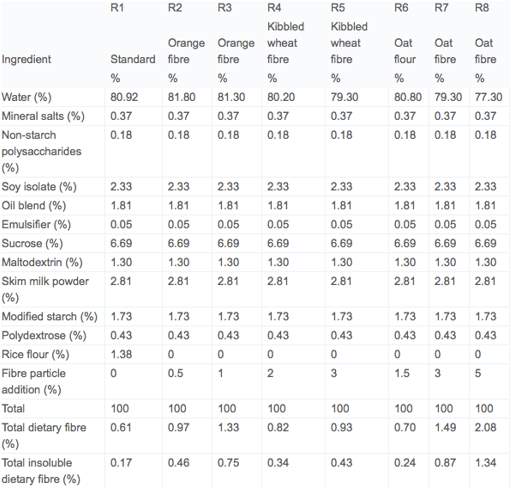
YOGHURT
Milk: Fresh raw buffalo whole milk and skimmed milk were received from the the National Dairy Research Institute (NDRI), Karnal (India).
Starter culture: The mixed culture NCDC-263 containing Streptococcus thermophilus and Lactobacillus bulgaricus were obtained from the National Collection of Dairy Cultures, NDRI, Karnal.
Dietary fibers: Dietary fibers used in the study viz. oat fiber (Vitacel® HF-600®), soy fiber (Fimbrim®) and inulin (Raftiline® ST) were supplied by M/sJ. Rettenmair and Sohne Gmbh (Germanay), M/s Solae Company (Gurgaon, India) and M/s Orafti Active Food Ingredients (Belgium), respectively.
According to the procedure described by Raju and Pal (2009), Misti dahi was prepared from slimming buffalo milk. Fresh raw buffalo milk is divided into four batches of 2.5 kg each, using fresh raw dehydrated milk and skim milk powder (SMP), respectively, standardized 3% milk fat and 15% solid unsaturated fat (SNF). All batches are preheated to 60-65 ° C. Sucrose and caramel were added at a rate of 14 g / 100 mL and 0.1 g / 100 mL, respectively. Among the four batches, the three enhanced the dietary fiber of each inulin (T2), soybean fiber (T3) and oat fiber (T4) per 100 mL of mixture was 1.5 g, and those fibers not added with fiber were used as control (T1 ). All batches were homogenized in a two-stage homogenizer (M / s Goma Engineers, Mumbai). All batches of the soy mixture were pasteurized at 90 ° C for 10 minutes and then cooled to 45 ° C. The initial culture was then added at a rate of 2 g / 100 mL per batch and loaded into a pre-sterilized 100 mL standard cup (M / s Tarsons Products Pvt. Ltd., Calcutta). Incubate at 42 ± 1 ° C for about 5-6 hours. Once the desired acidity is achieved, the cup is transferred to refrigerated (6-8 ° C) without affecting the solidified product. All trials were conducted in triplicate.
- Analysis of physico-chemical properties of UHT beverage and Yoghurt
Color: the colour profiles of different UHT samples and Yoghurt samples using chroma meter (Konica Minolta, Tokyo, Japan) and “Colorflex” colorimeter supplied by Hunterlab respectively. readings for both the products were based on CIELAB scale, where L⁎ values indicate the level of light or dark, the a⁎ value indicates redness or greenness, and the b⁎ value indicates yellowness or blueness.
Sensory evaluation: Both the products were analyzed for colour, appearance, texture and taste and were marked according to Hedonic scale.
Particle size distribution: Mastersizer X (Malvern Instruments, Malvern, UK) was employed to measure the particle size distribution (d(v,0.9)) of UHT samples using the laser light scattering principle.
RESULTS AND DISCUSSION:
Ingredients play a major role in affecting the sensorial, physical and chemical attributes of the product. In this study, incorporation of dietary fibres in yoghurt and UHT beverages affected the properties of product. Table 2, represented the difference between the yoghurt containing dietary fibres and a normal yoghurt.
Table 3: Comparison of yoghurt with dietary fibre incorporated and without (Consalvo, 2013; Green Mountain Creamery, n.d.).
| Composition | Yoghurt without dietary fibre (150g) | Yoghurt with dietary fibre (150g) |
| Calories per serving | 150 | 110 |
| Calories from Fat per serving | 20 | 0 |
| Total fat | 2g – 3% | 0g – 0% |
| – Saturated fat | 1.5g – 7% | 0g – 0% |
| – Trans fat | 0g – 0% | 0g – 0% |
| Cholesterol | 15mg – 5% | 0mg – 0% |
| Sodium | 90mg – 4% | 65mg – 2% |
| Potassium | – | 200mg – 6% |
| Total Carbohydrate | 22g – 7% | 15g – 5% |
| – Dietary Fiber | 0g – 0% | 0.5g – 2% |
| – Sugars | 19g | 12g |
| Protein | 9g – 18% | 12g – 24% |
| Vitamin A | 0% | 0% |
| Vitamin C | 0% | 0% |
| Calcium | 25% | 15% |
| Iron | 0% | 2% |
* Percent Daily Values are based on a 2,000 calorie diet.
- Changes in properties of dietary fibre incorporated UHT beverages after storage
Shelf life stability of dietary fibre included UHT beverages includes a few characteristics, pH, colour, viscosity, sensory are all parameters that could change the final shelf life. UHT beverages coupled with aseptic packaging is widely used in beverages to increase the shelf stability, however the conditions vary with dietary fibre inclusion. Different storage conditions and different types of insoluble fibre all interfere the final product storage stability and consistency.
There are four types of insoluble fibres that are used most in the UHT beverages, which are orange fibre fineground, kibble wheat fineground, oat flour micromilled and oat fibre micromilled. The temperature of storage is kept at 22 ℃ and 30 ℃ which is the temperature of industrial interest (Alqahtani, et al, 2014). The total dietary fibre content of orange fibre, kibbled wheat, oat flour and oat fibre are 71.90%, 10.70%, 6.20% and 29.30% respectively, with the insoluble dietary fibre accounting for about 80% of the total dietary fibre (Alqahtani, et al, 2014).
Table 4: Original particle size distribution and proximate composition of the 4 types of dietary fibre.
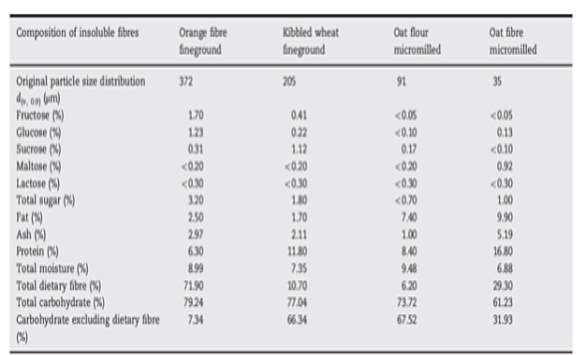
Different dietary fibre gives different particle sizes and further gives various sensory and colour properties. The storage at 22 ℃ and 30 °C for 12 weeks only gives slightly changes on colour properties, the colour change remain effectively indistinguished by eye from the standard preparations. Fresh standard samples receive L*, a*, and b* values of 86.83, -1.88 and 11.84, while the dietary fibre incorporated samples receive lower L* and higher a* and b* before storage (Alqahtani, et al, 2014). For instance, wheat fibre incorporated sample has a L* 73.66 which is smaller than original sample. However, after 12 weeks of storage, the colour does not change from the test prior to the storage. pH stays at neutral (around 6.7) after storage at 22 ℃ and 30 ℃ respectively, so the UHT product remains shelf life stable. Moreover, UHT samples stored at 22 and 30 °C demonstrated consistent levels of total solids (17-23%) during 12 weeks storage (Yangilar, 2013).
- Changes in properties of dietary fibre incorporated yoghurt after storage
Fibre inclusion causes significant changes in colour of yoghurt, a study on misti dahi, a indian yoghurt dessert found lightness (L*) values depends on different fibre types varies the result. Soy and oat fibre decrease the lightness significantly compare to the misti dahi without dietary fibre inclusion. Whereas inclusion of inulin increases the lightness significantly. Staffolo et al. (2004) found that among different fibres studied, only apple fibre addition imparted distinctive brownish colour and lower L* value to yoghurt. For prebiotic fibre fortified yoghurt with Hydrobind (an off-white to light grey coloured commercial dietary fibre), the L* values is lower than other dietary fibres (Raju & Pal, 2014). The redness value of misti dahi increased significantly with soy fibre and insulin fortification while significantly reduced with oat fibre fortification. The yellowness increased with inulin whereas decreased with oat incorporation (Raju & Pal, 2014). Moreover, an increase in a*(less greenness) is observed for all types of yoghurt, shirai et al. (1992) found that whey released by the gel contains riboflavin which has a very important green component which is absorbed by fibre.
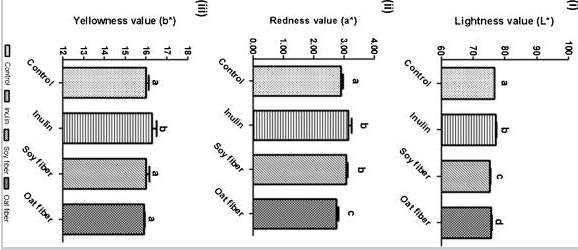
Figure 1: Effect of dietary fibers on colour of mishi dahi: (i) lightness (L*); (ii) redness (a *); and (iii) yellowness (b *).
The pH of yoghurt decreases dramatically at first 7 days and still decrease at slower rate till 14 days after storage. After 28 days of cold storage the pH stabilised ranging from 4.20 -4.30 and concentrations of 1.1%-1.3% of lactic acid in spite of the evolution along storage (Garcia-Perez et al., 2005). The high pH decrease rate in the first 7 days is considered to caused by high bacterial metabolic activity with consumption of lactose and the consequent increase of lactic acid and galactose. Yoghurt syneresis is depended on the percentage of fibre added. The addition of 0.6% and 0.8% of fibre had a breakening effect in the gel structure, which increases the syneresis effect. When 1% of fibre is added, because the high water holding capacity of the fibre absorbs the whey released by the gel structure, the syneresis is compensated. Moreover, the syneresis increased along cold storage with all types of yoghurt with fibre inclusion regardless of the type (Garcia-Perez et al., 2005).
Sensory Evaluation of Dietary fibres in UHT Beverages
Sensory analysis on food product is widely used all over the world to get familiar with consumer acceptance level. There are different sensory analysis/tests such as, descriptive analysis, paired comparison test, one tailed sensory test, two tailed sensory test and hedonic test.
Hedonic test is commonly used for the overall acceptability of the product. It includes a scale of 7 points in which 1 is dislike very much and 7 represents like very much. According to peered review article a sensory analysis on incorporation dietary fibres in UHT beverages was performed. Furthermore, smoothness, colour, texture, thickness, flavor, sweetness and overall acceptance were the main attributes in this experiment and results for each attribute were calculated using one way variance ANOVA (Alqahtani, et al, 2014).
Table 5: The table below displays the sensory evaluation on fresh UHT samples using 7 point hedonic scale (Alqahtani, et al, 2014).
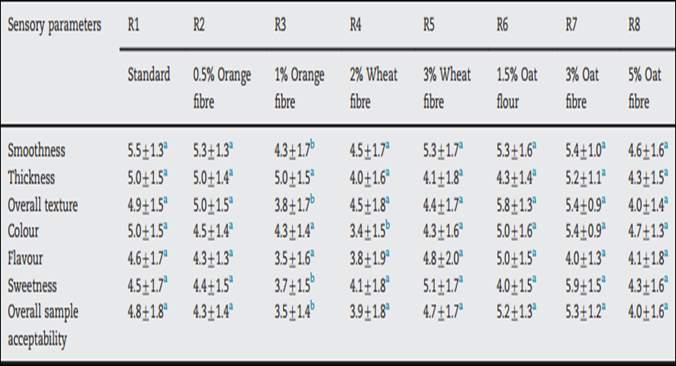
Sensory evaluation on fresh UHT beverages was performed by consumer panels who have been using liquid breakfast on daily basis. According to table 1, it has been concluded that the samples were acceptable to consumer’s panel with the score of 4.8 out of 7 with regards to overall acceptability (Alqahtani, et al, 2014).
Moreover, the result displayed a low score in regards to overall acceptability for orange and wheat fibre in comparison to standard (R1). Sample of oat flour and oat fibre showed high scores of 5.2% and 5.3% for overall acceptability. Whereas, 3% wheat fibre (R5) has a score of 4.7 which is very close to the standard (R1) score of 4.8. However, the incorporation of 1% orange fibre (R3) has a significant impact on overall acceptability of UHT beverage with the score of 3.5.
It has been suggested that the insoluble dietary fibres have a direct impact on the sensory profile of UHT beverages (Alqahtani, et al, 2014). The more dietary fibres in UHT beverage resulted in less overall acceptability. According to the results from peered review article it is concluded that UHT beverages with 3% oat fibre are more preferable by consumers and can be taken into consideration of fibres content into UHT liquid breakfast (Alqahtani, et al, 2014).
Sensory Evaluation of Dietary fibres in yoghurt
Sensory evaluation on misti dahi samples was performed on its different attributes such as, color, texture, body, flavour and overall acceptability using 9 point hedonic scale from 1 extremely disliking and 9 liking extremely. Sensory test results were obtained by 6 semi trained panelists within the age of 49 to 62 years (Raju & Pal ,2012).
Random cup of 100mL from each treatment was served to the panelists for judging. Furthermore, the scores for appearance and color were evaluated by looking at the FFMD and presence or absence of whey separation on the surface.
Moreover for mouthfeel a spoon of FFMD was placed in mouth to notice how it sticks to the sides and tongue. For texture test the overall firmness of FFMD was observed and different results were given by panelists. In addition, the flavor score was given to FFMD in regards to its acidity, sweetness and caramel taste (Raju & Pal ,2012).
There are different effect of dietary fibers with regards to sensory attributes when added to misti dahi. The results displayed higher score for color and appearance for control misti dahi compare to misti dahi containing fibers. Among all the samples oat fibers in misti dahi was given the lowest score 5.39 as shown in figure 1. It is due to the formation of layer of settled oat fiber which was observed in all samples of misti dahi containing oat fiber (Raju & Pal ,2012).
According to peered review article oat fiber used in this study contains 93% insoluble fiber which settled at the bottom of the cup and resulted in unacceptable appearance when incubated. Furthermore, misti dahi containing soy fiber and inulin received a lower score of 7.64 and 7.88 which is lower compare to control that is 7.97.
Moreover, for body and texture inulin and oat fiber were given low score as shown in figure 1 (graph ii). The reason behind this could be weak gel formation due to the interaction of fiber and milk solid. However, misti dahi containing soy fiber were comparable to control as there isn’t much of a difference.
In addition it has been investigated that the incorporation of fibers effect the flavor of misti dahi as shown in figure 1 (graph iii). The results displayed that inulin and oat fiber have lower score for flavors whereas soy fiber and control were not significantly different.
The overall acceptability results are displayed in figure 1 (graph iv), which concluded that oat fiber containing misti dahi received the lowest score for overall acceptability. On the other hand, inulin and soy fiber were given same score for overall acceptability but not comparable to control sample of misti dahi. However, the mean score of inulin and soy fiber is above 6.5 which indicates that these fibers can be used in manufacturing of misti dahi and would be considered as acceptable quality to consumers (Raju & Pal ,2012).
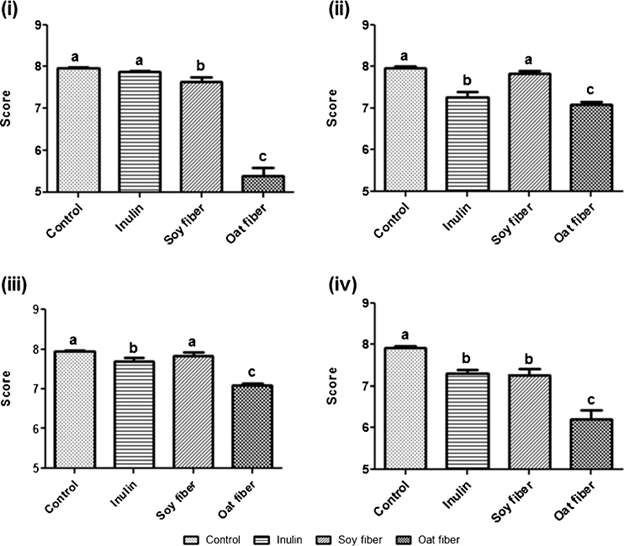
Figure 2: The figure above displays the effects of dietary fibers on sensory attributes of misti dahi. (i) colour and appearance; (ii) body and texture; (iii) flavour; and (iv) overall acceptability.
Effect of particle size distribution on viscosity of UHT beverages
Particle size plays an important role in controlling a number of events such as the digestion of food in relation to transit time and fermentation .The types of cell walls presents in the foods and the degree of processing can affects the particle size. Particle size of fibres may vary during transit in the digestive tract as a result of grinding, chewing, and bacterial degradation in the large intestine. Gritty texture can found in food products enriched with insoluble dietary fibre. Characterization of particle size distribution is an essential parameter in suspension rheology in production of UHT beverages with enhanced healthy profile. The smoothness of the beverages are depends on the particle size, mass, density and the medium of dispersion which influences the frictional resistance in liquid matrices (Alqahtani et al., 2014).
Table 6: Particle size of fibre in UHT treated beverages(Alqahtani et al.,2014)
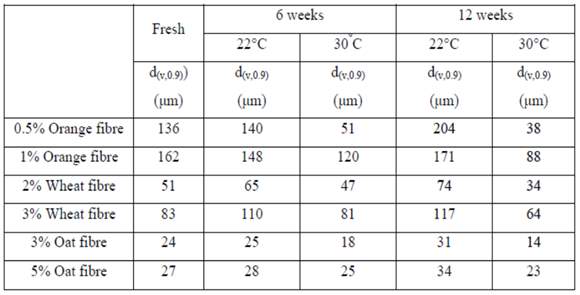
Figure 1 showed the particle size distribution of dietary fibre in UHT beverages stored for 12 weeks at 22°C is higher than those stored at 30°C .This is due to a better network formation between partially soluble (e.g. starch) and insoluble materials at the lowest experimental temperature.
- Effect of storage time and temperature on viscosity
The viscosity alters at different storage time and temperatures. Changes in viscosity values of UHT samples stored at 22 ℃ over a 12 weeks period of observation are shown in figure 2. The (ηt/η0) is the ratio of viscosity at a particular storage time (ηt) over the initial viscosity at zero time (η0). Longer storage time results in a considerable increase in viscosity of all UHT beverages made of orange fibre, wheat fibre or oat fibre and the increase in thickness in flow properties is more than 100% for the original preparation.
As mentioned in the previous section, there is an increase in particle size distribution over time for UHT samples stored at 22 ℃ which will result in increasing viscosity. Partially soluble hydrocolloid molecules (i.e. starch) within the fibre particles form a synergistic network with insoluble fibre fractions which prevents the insoluble materials from precipitating out of solution. This network formation over time form partially dissolved and swollen fibre particles that has a positive effect on the viscosity of the UHT beverages (Alqahtani, et al, 2014).
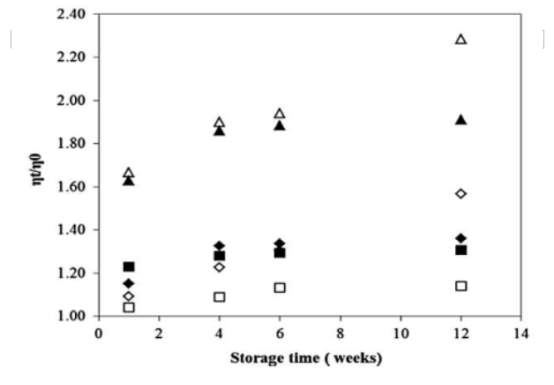
Figure 3: Changes in viscosity of UHT samples stored over a 12 week period at 22 ℃ (◆ 0.5% orange fibre, ◇1% orange fibre, ■ 2% wheat fibre, □3% wheat fibre, ▴ 3% oat fibre, ▵5 % oat fibre. )
Figure 3 shows changes in the values of normalised viscosity for UHT samples stored at 30 ℃ over 12 weeks. The viscosity decrease considerably which is the opposite of the samples stored at 22 ℃. This is because the elevated temperature allows better hydration of starch molecules and other soluble hydrocolloids found in fibre particles (Alqahtani, et al, 2014). These molecules can diffuse within the beverage matrix to form intermolecular associations with similar counterparts. Long term storage at 30 ℃ eventually leads to the formation of aggregates from the originally soluble hydrocolloid molecules. Aggregates demix from the beverage solution, hence being unable to support the insoluble fraction of fibre particles leading to a viscosity reduction during storage (Alqahtani, et al, 2014).
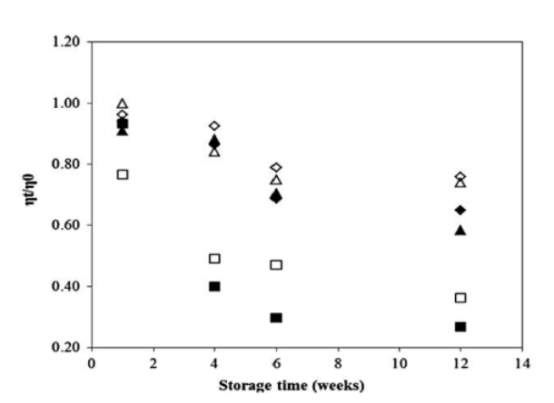
Figure 4: Changes in viscosity of UHT samples stored over a 12 week period at 30 ℃ (◆ 0.5% orange fibre, ◇1% orange fibre, ■ 2% wheat fibre, □3% wheat fibre, ▴ 3% oat fibre, ▵5 % oat fibre. )
In conclusion, storage at ambient temperature increases progressively the thickness of fibre containing beverages, whereas storage at 30 °C leads to a drop in viscosity and a thinner aqueous matrix in the UHT beverage. Viscosity is the major characteristic that changes during the storage thus interfere the shelf life stability. Other parameters such as colour, PH, total solid content remains consistent.

Figure 5: Effect of concentration and particle size distribution on the viscosity of UHT samples stored at 22°C for 12 weeks. ♦orange fibre- d(v,0.9),162μm , ■wheat fibre- d(v,0.9),83 μm, ▲oat fibre- d(v,0.9) ,24μm (Alqahtani et al.,2014).
Alqahtani et al.(2014) indicated wheat fibre with d(v,0.9) of 83 μm produces much higher viscosity than oat fibre with d(v,0.9) of 24 μm at the same level of fibre addition (3%).Furthermore, within the same type of fibre and as the fibre concentration increases ,the viscosity also rises.There is a positive relationship between the particle size distribution and steady shear viscosity.Fibre with large particle size are more viscous than fibre with small particle size due to the larger particle size, networks are easier to form, which results in more particle interactions between the substances and eventually leading to a high apparent viscosity(Alqahtani et al.,2014).
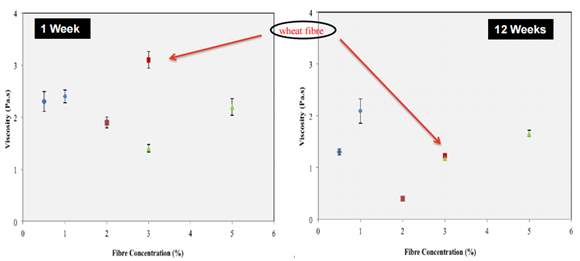
Figure 6: Effect of concentration and particle size distribution on the viscosity of UHT samples stored at 30°C for 12 weeks; ♦orange fibre- d(v,0.9),162μm , ■wheat fibre- d(v,0.9),83μm, ▲oat fibre- d(v,0.9) 24μm (Alqahtani et al.,2014) .
Following 12 weeks of storage, the viscosity of wheat fiber decreased. Alqahtani et al.(2014) indicated that prolonged storage at temperature 30°C allow better hydration of starch molecules, which form intermolecular structures that fall out of solution resulting in a drop in viscosity.
- Texture attributes of yoghurt incorporated with dietary fibres.
Misti dahi is a caramel colored set style sweetened yoghurt. Three different types of dietary fibre (inulin, soy fibre and oat fibre) were incorporated into the yogurt and the incorporation of different dietary fibre can affects the texture of misti dahi. Textural attributes such as firmness, stickiness , work of shear and work of adhesion were determined. Among the four batches, they were fortified with 1.5 g dietary fibres each of inulin (T2), soy fibre (T3) and oat fibre (T4) per 100 mL of mix and the one to which no fibre were added was treated as control (T1)(Raju & Pal ,2012).

Figure 7: Effect of dietary fibres on textural attributes of misti dahi: (i) Firmness. Each observation is a mean ± SD of three replicates (n = 3). abcd mean values of treatments within a graph with different letters significantly differ (p < 0.05)(Raju & Pal ,2012).
The addition of fibre decreased the firmness of the product. It can observe that the incorporation of oat fibre into the misti dahi resulted in lowest firmness value. This could be attributed to the breaking effect in the gel structure (Raju & Pal, 2012). The interactions of the fibre with milk solids that led to weak gel formation. The disrupting effect on the gel structure also can produce an increment in syneresis (Raju & Pal ,2012).
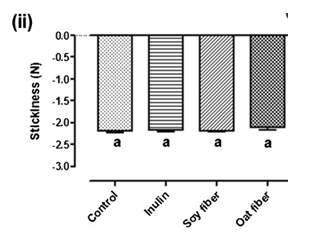
Figure 8: Effect of dietary fibres on textural attributes of misti dahi:(ii) Stickiness. Each observation is a mean ± SD of three replicates (n = 3). abcd mean values of treatments within a graph with different letters significantly differ (p < 0.05) (Raju & Pal ,2012).
Stickiness is an important sensory attribute of yogurt products which described as a feeling that can be perceived by tongue and palate. It can observed that the work of adhesion values increased by fortification with all the fibres. However, there were no significant differences in the stickiness when the incorporation of soy fibre, oat fibre and inulin into misti dahi(Raju & Pal ,2012).
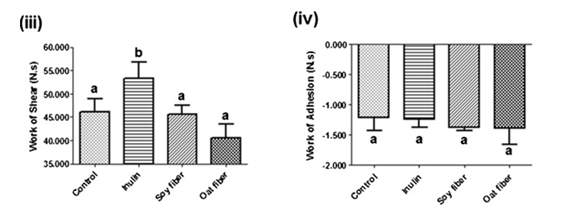
Figure 9: Effect of dietary fibres on textural attributes of misti dahi: (iii) Work of shear; and (iv) Work of adhesion. Each observation is a mean ± SD of three replicates (n = 3). abcd mean values of treatments within a graph with different letters significantly differ (p < 0.05)(Raju & Pal ,2012).
Work of shear is the amount of force required to perform the shearing process. It thus measures the resistance offered by the sample throughout the probe penetration.It can be observed that the addition of inulin significantly increased the work of shear than the control ,oat fibre and soy fibre.However,the incorporation of soy fibre and oat fibre decreased the work of shear in misti dahi (Raju & Pal ,2012).
Nutrition for yoghurt and UHT beverages
The addition of dietary fibre to yoghurt and UHT beverages allows for consumers to opt for healthier food choices. Dietary fibre aids in reducing the risk of developing coronary heart disease, obesity, hypertension, stroke, diabetes and certain gastrointestinal diseases (Anderson, et al., 2009). Furthermore, fibre improves insulin sensitivity and glycaemia in both diabetic and non-diabetic individuals (Anderson, et al., 2009). Men aged 19 years and older should be consuming 30 grams of dietary fibre per day whereas females 19 years and older should be consuming 25 grams per day (Australian Government: National Health & Medical Research Council, 2014) to ensure health benefits are observed. Dietary fibre is consisted from remnants of plant cells such as hemicelluloses, lignin, pectin, celluloses, waxes and gums where it is resistant to hydrolysis of enzymes in the human body, once digested. (Tomic, et al., 2017). Dietary fibre is placed into two classifications of soluble and insoluble fibre which is based upon their ability to digest within the human body (Rodríguez, Jiménez, Fernández- Bolaños, Guillén, & Heredia, 2006). Soluble fibre includes pectin, beta-pectin, galactomannan gums, inulin as well as a vast variety of other oligosaccharides (Rodríguez, et al., 2006). Dietary fibres are incorporated into food products to aid in stability, gelling agents, crystallisation inhibitors and thickening agents (Collar, Rosell, Muguerza, & Moulay, 2009). Fortifying foods with dietary fibre allows for an increase in the functional and health properties (Tomic, et al., 2017) of products where health-conscious consumers will repurchase the product.
Supplementing dietary fibre into yoghurt improves stability (Rodríguez, et al., 2006). The source of which dietary fibre is used performs an important role in the overall sensory and textural characteristics of a food product; for example, adding 1.32% of fibre derived from soy, corn, rice or sugar beet gave a grainy flavour and gritty texture to yoghurt (Tomic, et al., 2017). Whereas fibre derived from oat at the same level of 1.32%, improved the overall texture and body of the unsweetened yoghurts (Tomic, et al., 2017). New research has also shown that fibre obtained from carrots, being incorporated into yoghurt has allowed the production of lactic acid, decreased the pH, enhance the viscosity and water holding capacity whilst delivering remarkable taste and a smooth texture (Xu, Gu, & Xiao, 2016). Additionally, similar findings of pea dietary fibre have been discovered to reduce syneresis and increase viscosity which allows for an optimal commercial product (Damian & Olteanu, 2014).
Integrating dietary fibre into UHT beverages has proven to be difficult due to phase separation, sedimentary concerns, undesirable sensory, textural and visual characteristics (Alqahtani, et al., 2014). In order to overcome these obstacles, UHT processing and aseptic packaging have shown to produce stable beverages with high quality organoleptic qualities and extended shelf life (Alqahtani, et al., 2014) ultimately leading to commercial production. These qualities such as visual appearance, smoothness, flavour and nutritional quality play a significant role in customers repurchasing these products. Dietary fibre has shown to reduce the risk of chronic diseases (Anderson, et al., 2009), therefore ensuring a high nutritional quality is met, aids in the decision of consumers purchasing yoghurt and UHT beverages fortified with dietary fibre.
References:
Abdelrahim, K., Ramaswamy, H., & van de Voort, F. (1995). Rheological properties of starch solutions under aseptic processing temperatures. Food Research International, 28(5), 473-480.
Agarwal, V. & Chauhan, B. (1988). A study on composition and hypolipidemic effect of dietary fibre from some plant foods. Plant Foods For Human Nutrition, 38(2), 189-197. http://dx.doi.org/10.1007/bf01091723
Akoh, C., & Min, D. (2008). Food lipids (1st ed.). Boca Raton: CRC Press/Taylor & Francis Group.
Alting AC, Fred van de Velde, Kanning MW, Burgering M, Mulleners L, Sein A, Buwalda P. (2009). Improved creaminess of low-fat yoghurt: The impact of amylomaltase-treated starch domains. Food Hydrocolloids 23(3), 980–987.
Alqahtani, N. K., Ashton, J., Katopo, L., Haque, E., Jones, O. A. H., & Kasapis, S. (2014). Consistency of UHT beverages enriched with insoluble fibre during storage. Bioactive Carbohydrates and Dietary Fibre, 4, 84-92.
Augustin, M., Oliver, C., & Hemar, Y. (2010). Casein, caseinates and milk protein concentrates. In R. Chandan & A. Kilara, Dairy ingredients for food processing (1st ed., pp. 161-178). Wiley.
Baglio, E. (2014). Chemistry and Technology of Yoghurt Fermentation. Cham: Springer International Publishing, 62-63.
Consalvo, G. (2013). What’s in your Greek Yoghurt? Brand Comparison. Eat Well With Gina. Retrieved from: http://www.eatwellwithgina.com/2013/08/whats-in-your-greek-yogurt/
Craig, S.A.S., Anderson, J.M., Holden, J.F. and Murray, P.R. (1996) `Bulking Agents: Polydextrose’ in Carbohydrates as Organic Raw Materials (Van Bekkum, H., RoÈper, H. and Voragen, A.G.J., eds.), pp. 217±230, VCH, New York, NY
Craig, S.A.S. (2001) ‘Polydextrose: Analysis and Physiological Benefits’ in Advanced Dietary Fibre Technology (B. V. McCleary and Leon Prosky), 43:503-508, Blackwell Sciences, London, UK
Dalley, E. (2016, July 21). Liquid breakfasts – food and drink. Retrieved March 17, 2017, from https://www.choice.com.au/food-and-drink/drinks/juices-and-smoothies/articles/liquid-breakfasts.
Damian, C. (2013). Influence of dietary fibre addition on some properties of yoghurt. Ovidius University Annals of Chemistry. Volume 24, Number 1, pp 17-20, 2013. Retrieved from: https://www.degruyter.com/downloadpdf/j/auoc.2013.24.issue-1/auoc-2013-0003/auoc-2013-0003.pdf
Dhingra, D; Michael, M; Rajput, H & Patil, R. (2012). Dietary fibre in foods: a review. Ncbi. Retrieved from: https://www.ncbi.nlm.nih.gov/pmc/articles/PMC3614039
(1981). Dietary fibre and gastro-intestinal function. Food And Cosmetics Toxicology, 19, 400. http://dx.doi.org/10.1016/0015-6264(81)90432-6
Institute of Food Technologists (2016). Fat Replacers. (Food Technology Magazine, (52[3], 47-53. Retrieved from http://www.ift.org/knowledge-center/read-ift-publications/science-reports/scientific-status-summaries/fat-replacers.aspx
FSANZ,. (2015). Australia New Zealand Food Standards Code – Standard 2.5.3 – Fermented milk products. Food Standards Australia New Zealand. Retrieved from: https://www.legislation.gov.au/Details/F2015L00413
Foss JW.( 2000). How processing affects starch selection for yogurt. Bridgewater: National Starch & Chemical,22-25.
Gannon, M. C., Nuttall, F. Q., Krezowski, P. A., Billington, C. J., & Parker, S. (1986). The serum insulin and plasma glucose responses to milk and fruit products in type 2 (non-insulin-dependent) diabetic patients. Diabetologia, 29(11), 784-791.
Garcia-Perez, F. J., Lario. Y., Fernandez-Lopez, J., Sayas, E., Perez-Alvarez, J. A., & Sendra, E. (2005). Effect of Orange Fiber Addition on Yoghurt Color During Fermentation and Cold Storage. Color research and application; Vol.30(6), pp.457-463. DOI: 10.1002/col.20158
Green Mountain Creamery. (N.D.). Greek Yogurt Vermont. Green Mountain Creamery. Retrieved from: http://greenmountaincreamery.com/greek-yogurt-vermont
Hamdan, I. Y., Deane, D. D., & Kunsman Jr, J. E. (1971). Effect of Potassium Sorbate on Yoghurt Cultures 1. Journal of Milk and Food Technology, 34(6), 307-311.
Keogh, M. K., & O’kennedy, B. T. (1998). Rheology of stirred yogurt as affected by added milk fat, protein and hydrocolloids. Journal of Food Science, 63(1), 108-112.
Kim, S. H., & Oh, S. (2013). Fermented milk and yogurt. In Milk and Dairy Products in Human Nutrition: Production, Composition and Health. John Wiley and Sons, 163-168.
Luallen, T. (2004). Utilizing starches in product development. Starch in food: Structure, function and applications. Cambridge: Woodhead Publishing.
Matos Segura, M., & Rosell, C. (2011). Chemical Composition and Starch Digestibility of Different Gluten-free Breads. Plant Foods For Human Nutrition, 66(3), 224-230.
McCann, T., Fabre, F., & Day, L. (2011). Microstructure, rheology and storage stability of low-fat yoghurt structured by carrot cell wall particles. Food Research International, 44(4), 884-892. http://dx.doi.org/10.1016/j.foodres.2011.01.045
Mishra Pandey, S. & Mishra, H. (2015). Optimization of the prebiotic & probiotic concentration and incubation temperature for the preparation of synbiotic soy yoghurt using response surface methodology. LWT – Food Science And Technology, 62(1), 458-467. http://dx.doi.org/10.1016/j.lwt.2014.12.003
Mudgil, D., Barak, S., & Khatkar, B. (2016). Development of functional yoghurt via soluble fiber fortification utilizing enzymatically hydrolyzed guar gum. Food Bioscience, 14, 28-33. http://dx.doi.org/10.1016/j.fbio.2016.02.003
Payet, L., & Terentjev, E. (2008). Emulsification and Stabilization Mechanisms of O/W Emulsions in the Presence of Chitosan. Langmuir, 24(21), 12247-12252. http://dx.doi.org/10.1021/la8019217
Raju.P.N., & Pal.D.(2012). Effect of dietary fibers on physico-chemical, sensory and textural properties of Misti Dahi. Journal of Food Science Technology,51(11),3124–3133.doi:10.1007/s13197-012-0849-y
Roller, Sibel, and Sylvia A Jones. Handbook Of Fat Replacers. 1st ed. Boca Raton [etc.]: CRC Press, 1996. Print
Sendra, E, Kuri, V., Lopez, F ,J .,Barbera, S, E., Navarro, C & Alvarez, J, A .(2009) .Viscoelastic properties of orange fiber enriched yogurt as a function of fiber dose ,size and thermal treatment. – Food Science and Technology ,43(2)708–714.Retrived from http://hydh.hbstl.org.cn/uploadfiles/8YTEX6041301039698514.pdf
Shirai, K., Pedraza, G., Gutierrez-Durán, M., Marshall, V. M. E., Revah-Moiseev, S. and García-Garibay, M. (1992), Production of a yogurt-like product from plant foodstuffs and whey. Substrate preparation and fermentation. J. Sci. Food Agric., 59: 199–204. doi:10.1002/jsfa.2740590210
Staffolo MD, Bertola N, Martino M, Bevilacqua A. (2004) Influence of dietary fiber addition on sensory and rheological properties of yogurt. Int Dairy J. 2004;14:263–268. doi: 10.1016/j.ida
Sterza, G., GonCAlvez, D., PERez, C., Reolon, G., Segura, N., Lema, P., & GAMbaro, A. (2007). Influence of gelatin and starch on Citric acid/dextrose/sodium citrate. Reactions, 1135, 20. Ares, G.,
Tamime, A. & Robinson, R. (1999). Yoghurt: Science and Technology. 2nd edn. . Boca Raton, FL: CRC Press. Florida.
Tamime, A. & Robinson, R. (2007). Traditional and recent developments. In: Yoghurt Production and Related Products. Tamime and Robinson’s yoghurt. Boca Raton, Fla. U.K., pp. 348 – 467.
Tay, S., Kasapis, S., Perera, C., & Barlow, P. (2006). Functional and Structural Properties of 2S Soy Protein in Relation to Other Molecular Protein Fractions. Journal Of Agricultural And Food Chemistry, 54(16), 6046-6053. http://dx.doi.org/10.1021/jf060387a
Theander, O. & Åman, P. (1982). Studies on dietary fibre. A method for the analysis and chemical characterisation of total dietary fibre. Journal Of The
Furda, I. (Ed.). (1983). Unconventional Sources of Dietary Fiber: Physiological and in Vitro Functional Properties. American Chemical Society. 22(4), 315. http://dx.doi.org/10.1016/0278-6915(84)90013-9
Vaclavik VA, Christian EW. 1998. Sugars, sweeteners, and confections. In: Heldman D, editor. Essentials of food science. Maryland: Aspen Publishers, Inc. pp 25–38; 251–65.
Yangilar, Z. (2013). The Application of Dietary Fibre in Food Industry: Structural Features, Effects on Health and Definition, Obtaining and Analysis of Dietary Fibre: A Review. Journal of Food and Nutrition Research; 1(3):13-23. doi: 10.12691/jfnr-1-3-1.
Cite This Work
To export a reference to this article please select a referencing stye below:
Related Services
View allRelated Content
All TagsContent relating to: "Food and Nutrition"
Food and Nutrition studies deal with the food necessary for health and growth, the different components of food, and interpreting how nutrients and other food substances affect health and wellbeing.
Related Articles
DMCA / Removal Request
If you are the original writer of this dissertation and no longer wish to have your work published on the UKDiss.com website then please:




